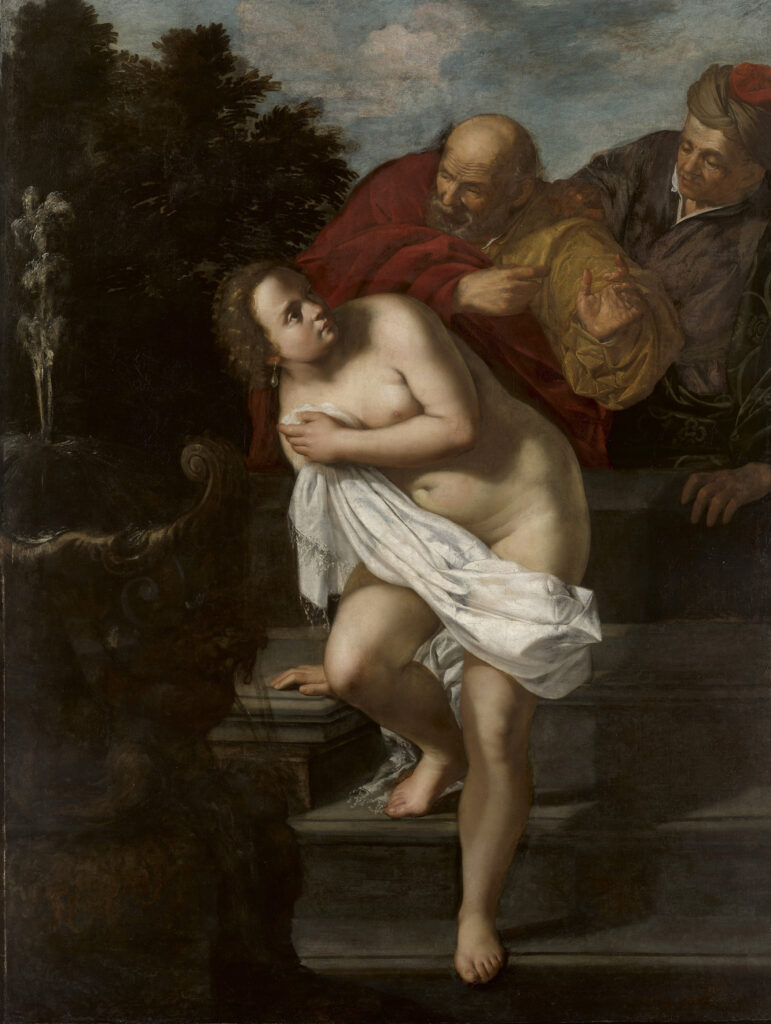The Royal Collection Trust has just announced that a painting by Artemisia Gentileschi has gone on display at Windsor Castle for the first time in almost two centuries.
The announcement comes at the end of a much-needed restoration work that the painting has undergone, as it was misattributed to “French School” and left in disrepair in a Hampton Court Palace storage room.
The painting is called “Susanna and the Elders”, and depicts the moment in which Susanna realises that two men are watching her bathe. In the biblical story, Susanna is then tried with for infidelity, before being proven innocent in the end.
This story seems to have a special place in Artemisia Gentileschi’s work, as there are at least six compositions that make use of it, always with an emphasis on the uncomfortable feeling of the woman, as opposed to all of the male painters, who tended to sexualise Susanna more.
According to the Royal Collection Trust, the painting was commissioned by Queen Henrietta Maria, consort of King Charles I, and, once finished, records from the time (1638-9) show that it hung above the fireplace in the Queen’s Withdrawing Chamber at Whitehall Palace, which the Queen used for more private audiences. The room itself had just been redecorated in preparation for a royal birth, and was equipped with a fireplace that was emblazoned with the Queen’s personal cypher, giving the painting a feel of belonging to Queen Henrietta Maria herself.
During the aforementioned record, the painting was also equipped with the “CR” cypher (Carolus Rex), showing that it was at one point in King Charles I’s possession. After restoration, it was passed down to King Charles II in 1660, and hung again above a fireplace, this time in Somerset House.

Research shows that the 1700s marked a waning of Artemisia Gentileschi’s reputation, and thus it is believed that it is around this time that the painting lost its attribution. Its last depiction is in an 1819 watercolour of the Queen’s Bedchamber at Kensington Palace, where it is shown leaning against a wall – a sign that the painter was considered a minor, and the work not worth hanging.
After that, we find the painting, already without a frame, in a storage room at Hampton Court, from where it is sent for another restoration.
It wasn’t until the Royal Collection Trust dug a bit deeper on the painting that it was discovered that it was actually one of the most important milestone pieces by a revolutionary artist, and the painting was immediately set up for the biggest restoration that many conservators have undertaken to date. One of the conservators described it as “the most heavily overpainted canvas I had ever seen, its surface almost completely obscured”.
Following months of painstaking work, the piece is now on display at Windsor Castle, in the Queen’s Drawing Room, alongside “Self-Portrait as the Allegory of Painting”, considered one of her greatest works.
Artemisia Gentileschi is one of the few female artists to be recognised when she was still alive – at the time, many females assumed male names in order to secure more success. She studied in Italy with her father Orazio, also a painter, and she followed him around the country, as well as in London, where they resided. It is believed that it is during this time that Queen Henrietta Maria commissioned her the painting.

